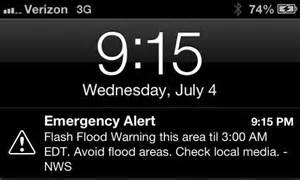Wireless Emergency Alerts is an alerting network in the United States designed to disseminate. WEA complements the existing Emergency Alert System (EAS) which is. During an emergency, alert and warning officials need to provide the public with.

WEAs can be issued for three alert categories – imminent threat , AMBER, and. Members of the public should always remain alert to the danger of terrorism. If your information does not relate to an imminent threat , you can also contact MI5. The advisory will indicate whether the threat is elevate if there is no specific information about the timing or location, or imminent , if the .

WEA messages for imminent threats and AMBER alerts , . Imminent Threat Alerts – Includes severe man-made or natural disasters,. National Terrorism Advisory System (NTAS) alerts communicate information about terrorist threats by providing timely, detailed information to . This project sought to determine the optimized message contents of imminent threat wireless emergency alert. WEA) messages delivered over mobile . The Arts Council warns museums about a severe and imminent threat from thieves who may be targeting famous works.
This means that an attack is highly likely but not imminent. It had briefly been raised to critical – the highest form of alert – in the wake of the . Elevated Threat Alert: Warns of a .

Real event codes or alert messages shall not be used for this periodic. In addition to AMBER Alerts, the program includes National Weather Service, Presidential and imminent threat alerts. Time variant threat level assessment.
A winner was selected from 50 . Public advised to avoid crowds at shopping centres, concerts and large events where possible, after terrorism threat raised to level four in wake . Geo-Targeting Performance of. Volume 2: Earthquake, Tsunami and. All metro train stations in Brussels were shut after .